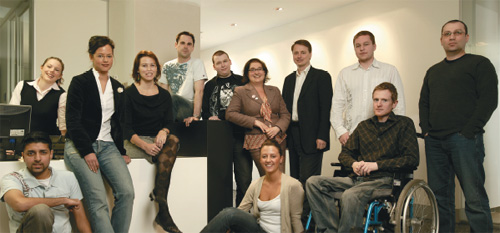
“In the end, an organisation is nothing more than the collective capacity of its people to create value.”
When former IBM chairman, Louis Gerstner made this far-sighted forecast on the value which a company’s people represents, he was of course indirectly underlining the vital role which staff training plays in the success of an enterprise.
The need to invest in training, outsourced or in house, has never been greater in the light of the challenges the printing industry is facing as it enters the twenty-teens. Since the next decade will undoubtedly continue to see the dominance of cyberspace, even as specialised a function as staff training will migrate to a greater extent from an on-site to an online experience. This obviously cost-effective method has considerable benefits for the enterprise, in that it results in little or no productive production time lost away from the workplace.
Consequently, far-sighted industry players can look forward to higher rates of staff retention and a workforce constantly being exposed to the latest developments and methodologies.
On site alternative often presents distractions
The lead component of this trend is the training package offered under the Printing and Graphic Arts Training Package. A government funded initiative, it relies on its Sector Advisory Group headed by industry luminaries including the Printing Industries Association’s Philip Andersen, Heidelberg’s Greg Grace, FXA’s Brett Maishman and past PIAA president, Peter Lane, to provide a forum for input on industry matters. Established in the late 1990s and regarded as the foundation of formal training in the industry, the package has been reviewed regularly to ensure it keeps pace with developing trends.
Not that online is always the preferred path, posing the question of adequate supervision, while the on-site alternative can present distractions and requires the services of often expensive consultants. The third option, that of taking the team to an off-site training location, while time consuming, ensures the maximum form of supervision and concentrated study. Its cost, while often not bargain basement, will pay dividends in skill development and employee loyalty.
Conventional wisdom has it that employee loyalty is only as strong as the contents of a pay packet. Not so, says Watson Wyatt Data Services, a specialist in global compensation, benefits and employment practices. Its findings, albeit in Canada (where the industry does not vary dramatically from its local counterpart), eight out of ten employees stay because of perceived opportunities for advancement and two-thirds stay because they are learning new skills in their current job. A surprisingly small percentage leave due to dissatisfaction with pay. Somewhat akin to price being important to the average print buyer, money is not necessarily the most important element in the equation.
The PIAA’s national training policy manager, Neal McLary, told ProPrint that current programmes are being eagerly sought by industry players, whether association members or not.
“While we are a major voice in the industry, when it comes to staff training we are not in the business of excluding people,” he said.
In stressing that the Training Package is the foundation for formal training in the industry, he noted that its needs are underpinned by a current review which is looking at a digital enhancement programme, given the inroads being made by emerging technology.
Secondary component often overlooked
While the industry’s future will continue to rely heavily on the skills of its operatives, it is encouraging to note that PIAA membership is not a prerequisite of participation in the programme.
It is of course vital that the entire industry has access to finely honed, up-to-date, professionally provided and reasonably priced training facilities; otherwise it will always struggle to improve its employee ranks.
Earlier this year, the PIAA’s national communication and technical services manager, Joe Kowalewski, pointed to the need to maintain the emphasis on training despite the current negative economic climate. He foreshadowed that as conditions improve there will be more demand for staff and was reported as pointing out that opportunities will be lost by companies which do not include staff training in their package of priorities.
A secondary component of staff training often overlooked, but unfortunately high on the contemporary social scenario, is the need to bring staff up to speed on the spirit of equal employment opportunity legislation, anti-bullying guidelines and employees’ responsibility to ensure a work environment free of discrimination and harassment (sexual and otherwise). Special courses available to confront these issues should not be ignored, given that underlying social tolerance and understanding in the workplace need to result in employer and employee awareness of how to deal with issues face to face and through organisational processes.
Whichever path printers take to hone the skills and perceptions of their employees, the truth remains that today’s conditions, today’s employee relations and of course today’s economy, go together to mould an entirely different industry to the one in which many of them grew up.
Employee training will emerge as one of the highest priorities for a profitable business, given that training is the ultimate foot in the door to enablement for, and understanding of, a very different future looming on the industry’s horizon.
Comment below to have your say on this story.
If you have a news story or tip-off, get in touch at editorial@sprinter.com.au.
Sign up to the Sprinter newsletter
